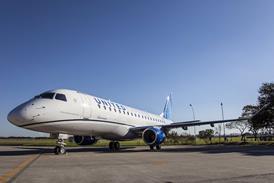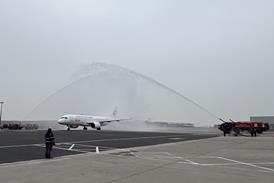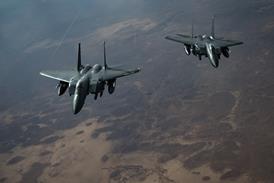Raytheon has tested a two-stage warhead concept designed to punch through 35ft (11m) of granite or 20ft of high-pressure concrete to penetrate cave complexes or hardened and buried bunkers.
The tandem warhead is designed for use against targets that other conventional weapons cannot penetrate, says vice-president strike weapons Harry Schulte, adding: "We think this is the biggest ever made."
In the two-stage concept, a shaped-charge precursor warhead is triggered a short distance from the target, forming a 10km/s jet of molten metal that drills through the rock or concrete, turning it to rubble. This clears the way for a follow-on warhead to penetrate the cave or bunker and explode.
While Raytheon's AGM-154 Joint Stand-Off Weapon uses a tandem warhead supplied by BAE Systems, the recent test involved a significantly larger precursor charge designed to penetrate much deeper and through harder and thicker concrete.
Sized to fit inside the US Air Force's AGM-129 Advanced Cruise Missile (ACM), the precursor warhead used in the test was 24in (610mm) in diameter and contained 500lb (230kg) of high explosive, says Schulte.

Before... © Raytheon
The target was a 330t block of high-pressure reinforced concrete 20ft thick. Normally concrete with a compressive strength of 5,000-6,000lb/in² is used, but for this test 12,600lb/in² concrete was used. "A kinetic [penerator] weapon would bounce off such high-pressure concrete," he says
Exploded three diameters - 6ft - from the target, the precursor warhead was expected to drill all the way through the 20ft-thick block, but actually penetrated to 19.5ft, Schulte says. Raytheon is now rerunning its computer models to find out why the penetration fell short of predictions.



During... © Raytheon
A second test is planned shortly with an 18in-diameter precusor warhead sized to fit in the US Navy's BGM-109 Tomahawk cruise missile. This will be tested against a 10,000lb/in² concrete target buried in the ground.
Raytheon is working with the US Navy in an effort to set up a Tomahawk technology demonstration that could lead to a flight test within 18 months and produce a weapon that could be fielded in 30 months.
The company has also talked to the US Air Force about converting the nuclear-armed ACMs to conventional warheads as they are decommissioned, but Schulte says there is no support yet for a demonstration flight.

After... © Raytheon
Source: FlightGlobal.com




















